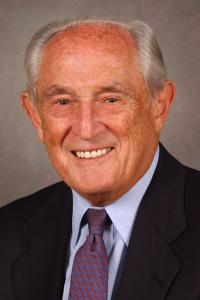|
Dr. Fink received his M.D. from New York University College of Medicine in 1945. He served as a medical officer in the US Army, 1946-47 and is certified as a specialist in neurology (1952), psychoanalysis (1953), and psychiatry (1954). He was appointed Research Professor of Psychiatry at Washington University in 1962, and then at New York Medical College (1966 to 1972), and since 1972 at SUNY at Stony Brook, where he is Professor of Psychiatry and Neurology Emeritus. Since 1997, he has also been on the faculty at AECOM and the LIJ-Hillside Medical Center.
His studies of ECT began at Hillside Hospital in 1952, and he has published broadly on predictors of outcome in ECT, effects of seizures on EEG and speech, hypotheses of the mode of action, and how to achieve an effective treatment. In 1972, with Drs. Seymour Kety and James McGaugh, he organized an NIMH sponsored conference on the biology of convulsive therapy which resulted in the volume Psychobiology of Convulsive Therapy (1974). In 1979, he published the textbook Convulsive Therapy: Theory and Practice (Raven Press, 306 pp.).
In 1984, he established CONVULSIVE THERAPY, a quarterly scientific journal, published by Raven Press (renamed Journal of ECT). From 1975 to 1978, and again from 1987 to 1990, he was a member of the Task Forces on Electroconvulsive Therapy of the American Psychiatric Association. In 1995-1996, he chaired the Task Force on Ambulatory ECT of the Association for Convulsive Therapy. In 1999, he published the trade bookELECTROSHOCK: Restoring the Mind (Oxford University Press, NY) that was re-issued in paperback in 2002.
He has received many prize awards for his research in ECT and in EEG, including including the Electroshock Research Award (1956), the A.E. Bennnett award of the Society of Biological Psychiatry (1958), the Anna Monika Prize award for research into depressive illness (1979), the Laszlo Meduna Prize of the Hungarian National Institute for Nervous and Mental Disease (1986), the Gold Medal award of the Society of Biological Psychiatry (1988), and Lifetime Achievement Awards of the Psychiatric Times (1995) and of the Society of Biological Psychiatry (1996).
In psychopharmacology, he established a classification of psychoactive drugs by digital computer analysis of EEG and has contributed to the effects of narcotic antagonists and of cannabis.
In 1997 he organized the 4-hospital collaborative study group known as CORE under grants from NIMH. That group is comparing the merits of continuation ECT with continuation lithium and nortriptyline in depressed patients who responded to bitemporal ECT. The study results will appear in the winter of 2005.
In the past few years, Dr. Fink has been interested in catatonia and the neuroleptic malignant syndrome. In 2003, Catatonia: A Clinician's Guide to Diagnosis and Treatment, a joint effort with Prof Michael A. Taylor of University of Michigan, was published by Cambridge University Press. Another effort,Ethics of ECT, with Professor Jan-Otto Ottosson of the University of Göeborg, Sweden, will be published by Brunner-Routledge Publishing Group in 2004. He is now working on a book on Melancholia with Dr. Taylor, to be published by Cambridge University Press in 2005; and concurrently, on a History of Convulsive Therapy with the Toronto (Canada) Professor of History of Medicine, Edward Shorter and the Reader in Psychopharmacology David Healy of Wales UK.
Dr. Fink lives in Nissequogue, New York with his wife Martha.
|

